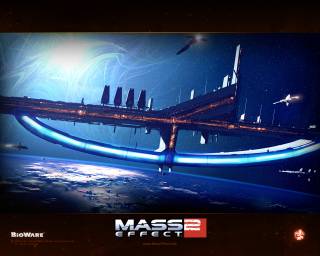
So I swallowed my pride and showed up to the last session of the last day of GDC, "The Iterative Level Design Process of Bioware's Mass Effect 2." Here's what I picked up that may interest those of you waiting for the game as impatiently as I am.
For the first Mass Effect, BioWare used a sort of concurrent design process by which members of the team from different departments--level design, story, art, and so on--built their respective components of each area simultaneously and then expected all of the pieces to fit together properly into a cohesive whole.
That didn't always happen. If the level was actually playable at the end of this process--and sometimes it wasn't--it often ran into problems like a significant drop in performance (and the company wasn't proud of the frame rate drops in the original game). The team tried to address these issues where they popped up, but since doing so required reworking "entire swaths of content," time and resource constraints meant the designers often had to live with the deficiencies.
In extreme cases, large pieces of content were removed completely. Caleston, a story-related "outland" planet with refineries and industrial cartels that was intended to be a part of the game's core story arc, was deleted from the game outright. We will never get that planet back, people. Shed a tear.
In Mass Effect 2, BioWare is using a linear, phased approach to level design that builds the levels step by step, starting with only the most important parts. This method has a couple of primary requirements: from the very outset, always keep your levels playable, and always keep them at target performance. The designers should only do the minimum of necessary work to answer the important questions about each level, most of which amount to "Can you still see how this will be fun when it's finished?"

During the presentation BioWare showed a brief production video from Mass Effect 2, which I would be remiss in failing to describe to you. There was a cutscene which took place inside a flying car traveling in the airborne traffic lanes of the Citadel. The conversation here involved an Asari character named Seryna--whose speech was just a little less formal than Liara's was in the first game--and an unnamed male Spectre wearing the trademark N7 armor. Granted, you could make your character look however you wanted in the original game, but this character looked nothing like the male Shepard with the shaved head from the first game. So maybe he really is dead? I don't know what to believe anymore.
So there's your nugget of new information. There's an Asari named Seryna in Mass Effect 2--or BioWare put a little bait-and-switch in that demo video to make people like me look awfully foolish. Let's look forward to finding out which it is!
Perhaps most importantly, the company mentioned at the end of the talk that this new design process will allow the team to identify problem areas and poor performance earlier on in development, allowing them to smooth out rough frame rates and, yes, speed up those horrendously slow space elevators.